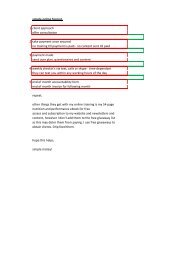Create successful ePaper yourself
Turn your PDF publications into a flip-book with our unique Google optimized e-Paper software.
THE BARBELL BENCH PRESS<br />
Despite being probably the easiest compound lift it seems that this lift causes most injuries.<br />
Technically it still requires much thought <strong>and</strong> to perform it correctly you need to know the following<br />
basics.<br />
<br />
<br />
<br />
<br />
<br />
<br />
<br />
<br />
<br />
<br />
<br />
<br />
Lie down on the bench <strong>and</strong> make sure you un-rack it from just behind the head. Certain<br />
machines will allow you to keep it racked whilst pulling it forward but most don’t. A spotter<br />
can come in very h<strong>and</strong>y when performing this specific lift for help racking <strong>and</strong> un-racking the<br />
bar<br />
Pinch your shoulder blades together <strong>and</strong> engage the lats. Drive the shoulders into the bench<br />
<strong>and</strong> keep your feet flat on the floor with a wide stance. This helps to engage the chest <strong>and</strong><br />
stop you using predominantly anterior delt activation. Keeping your feet flat <strong>and</strong> based will<br />
help you to drive through the rep<br />
There should be a slight arch in the lower back. No more than a fist <strong>and</strong> your butt should stay<br />
on the bench throughout the set. If it lifts, then chances are the weight is too much<br />
Grip the bar about an inch or two out from shoulder width (generally, speaking). Hold it in the<br />
palms <strong>and</strong> not the fingers <strong>and</strong> squeeze it nice <strong>and</strong> tight<br />
Keep your arms locked in <strong>and</strong> make sure the rep starts directly above the chest <strong>and</strong> nipples<br />
once you have manoeuvred the bar into place<br />
Your arms should be around 45 degrees to your body, having the straight out will stop full<br />
activation of the chest muscles, al lot closer to the body is generally used by powerlifters<br />
Take a deep breath <strong>and</strong> keep the whole body nice <strong>and</strong> tight<br />
At a steady controlled pace lower the bar directly down towards the chest until it almost<br />
touches (or just touches) but do not bounce it off the chest for momentum<br />
Then drive the bar back up towards the ceiling with everything you’ve got. Keeping the chest<br />
up. Avoid rounding your shoulders to have the deltoids push it up<br />
Keep the head flat on the bench. Don’t raise it up to look at the bar. Stay focused on the<br />
ceiling. This will help to keep a vertical lift <strong>and</strong> avoid injury<br />
The body should not have changed at all during the rep. The core would have been kept tight<br />
throughout. Exhale as you reach the top of the rep<br />
Deep breath. Reset the body. Repeat.<br />
Some common mistakes to avoid:<br />
Rounding of the shoulders forcing the anterior (front) deltoids to work more than the pectoral<br />
muscles. Feet are sometimes placed on the bench as opposed to the floor. H<strong>and</strong> positioning that<br />
leaves the bar placing to much force on the wrist as opposed to the whole arm. Raising of the head<br />
during reps. Improper functioning of the lats <strong>and</strong> shoulder girdle. Lifting the butt <strong>and</strong> twisting the<br />
back to finish the rep. bouncing the bar of the chest <strong>and</strong> dropping the bar down uncontrollably.<br />
Instability sometimes causes the bar to fail to travel in a vertical line.<br />
43




